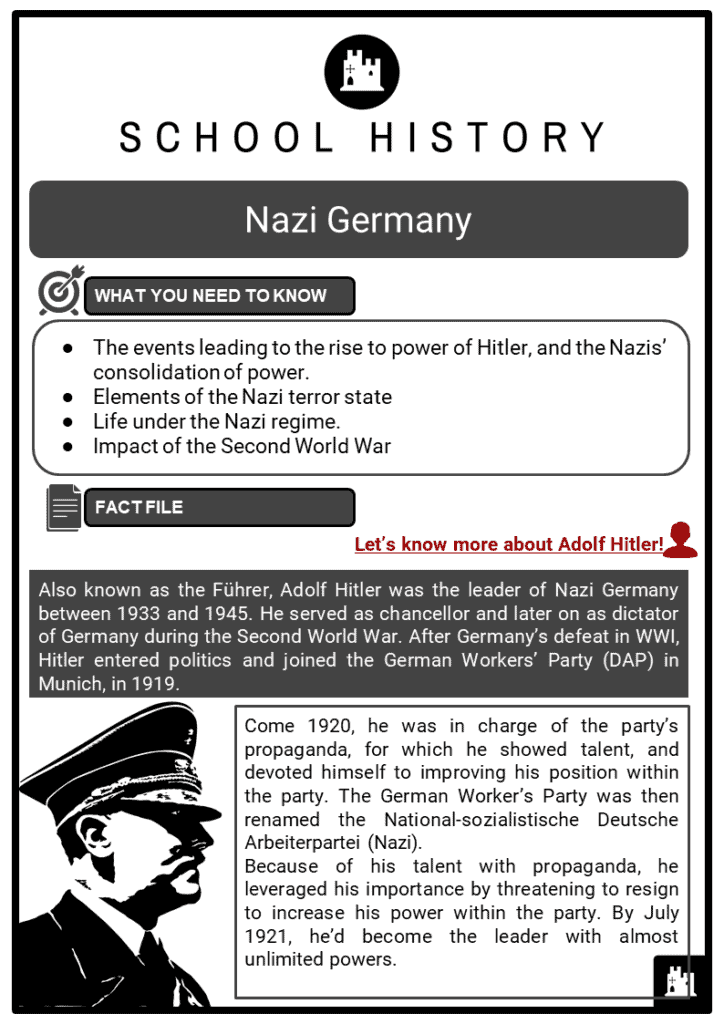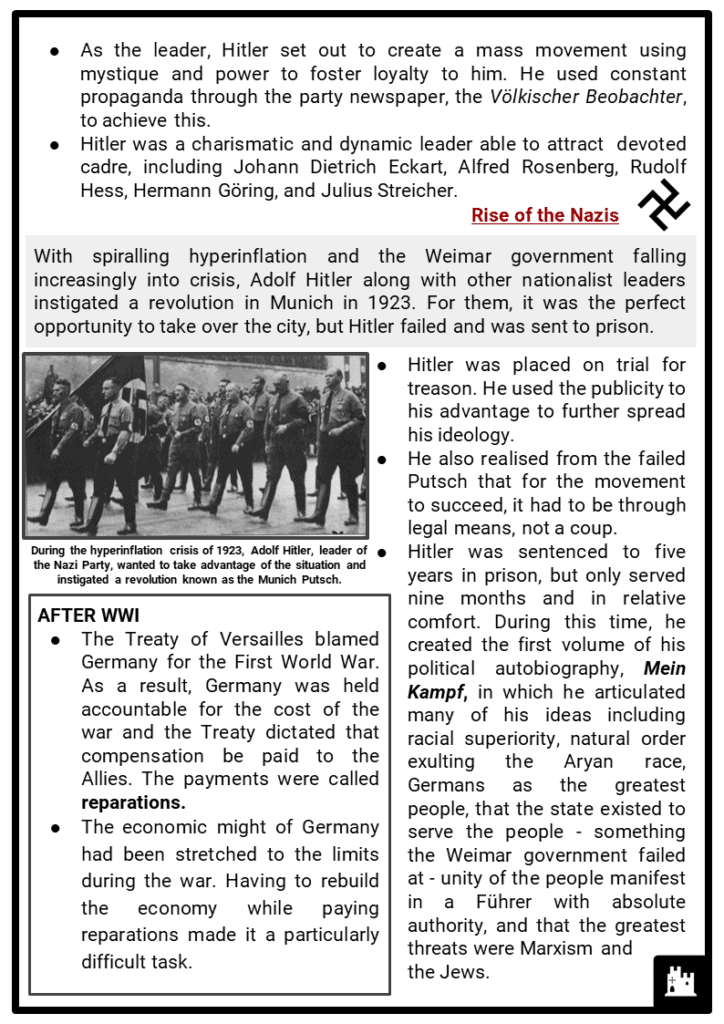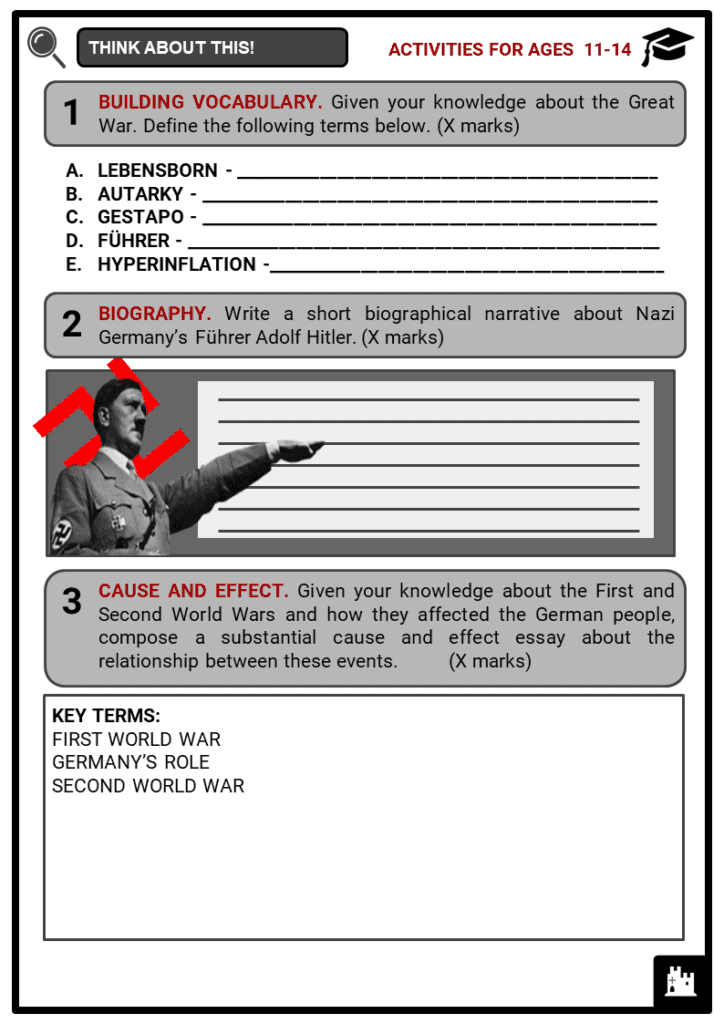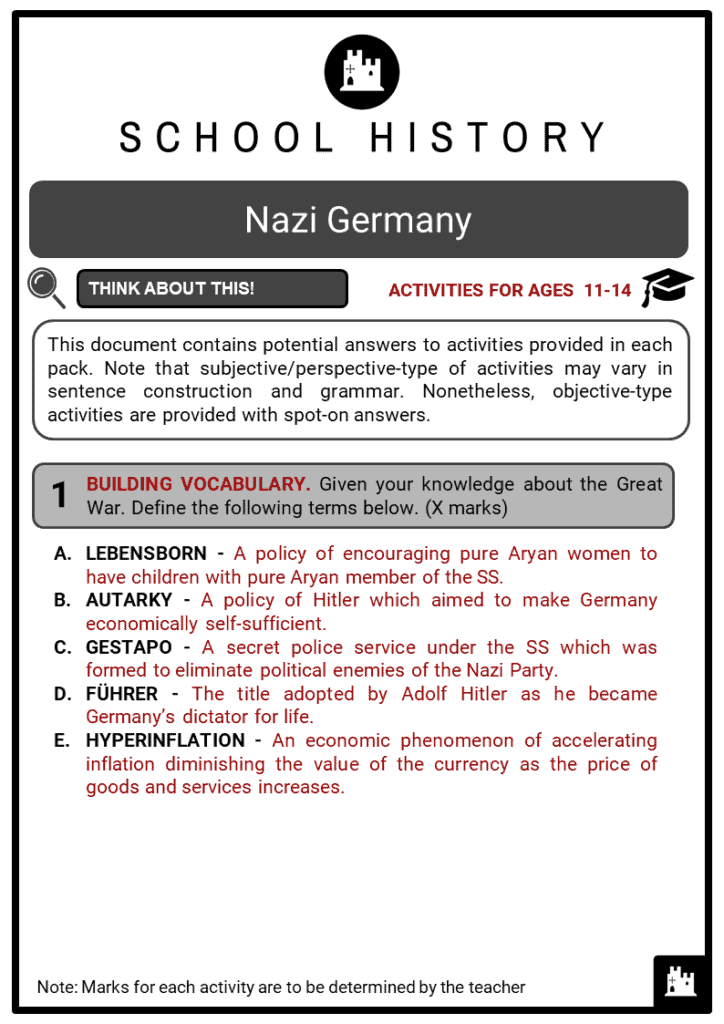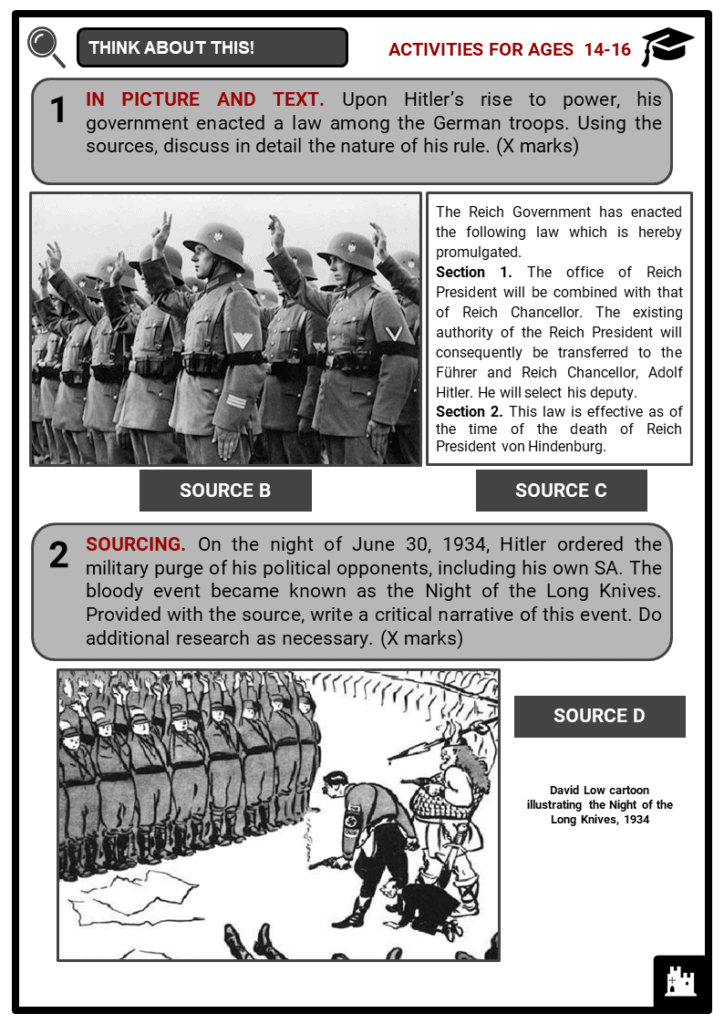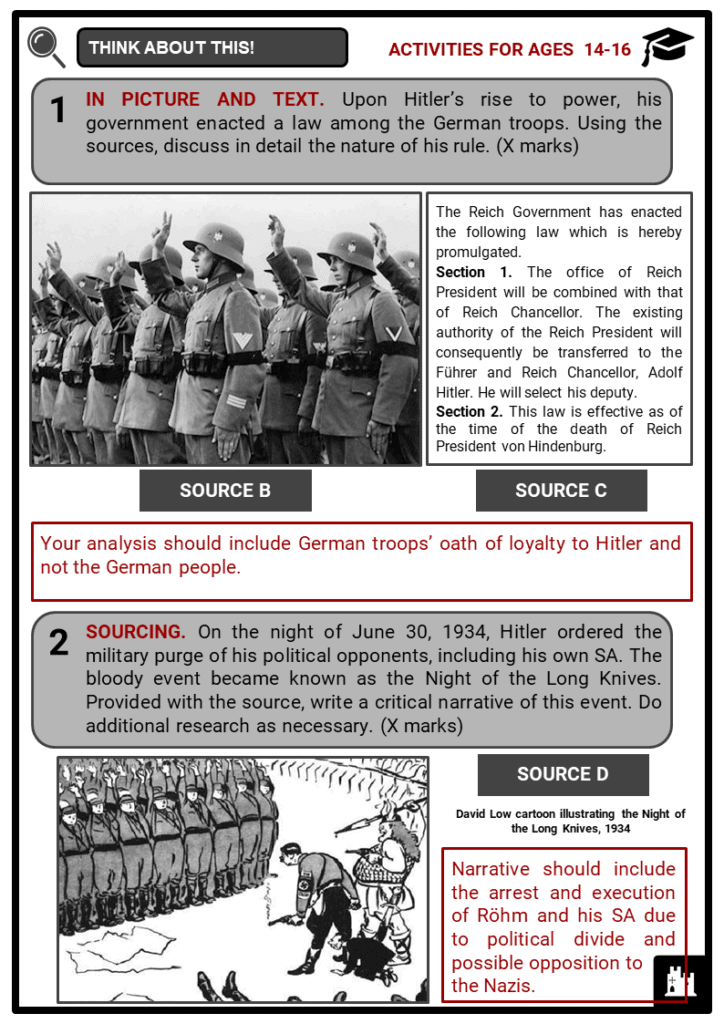Download Nazi Germany Worksheets
Do you want to save dozens of hours in time? Get your evenings and weekends back? Be able to teach Nazi Germany to your students?
Our worksheet bundle includes a fact file and printable worksheets and student activities. Perfect for both the classroom and homeschooling!
Table of Contents
Add a header to begin generating the table of contents
Summary
- The events leading to the rise to power of Hitler, and the Nazis’ consolidation of power.
- Elements of the Nazi terror state.
- Life under the Nazi regime.
- Impact of the Second World War
Key Facts And Information
Let’s know more about Adolf Hitler!
- Also known as the Führer, Adolf Hitler was the leader of Nazi Germany between 1933 and 1945. He served as chancellor and later on as dictator of Germany during the Second World War. After Germany’s defeat in WWI, Hitler entered politics and joined the German Workers’ Party (DAP) in Munich, in 1919.
- Come 1920, he was in charge of the party’s propaganda, for which he showed talent, and devoted himself to improving his position within the party. The German Worker’s Party was then renamed the National-sozialistische Deutsche Arbeiterpartei (Nazi).
- Because of his talent with propaganda, he leveraged his importance by threatening to resign to increase his power within the party. By July 1921, he’d become the leader with almost unlimited powers.
- As the leader, Hitler set out to create a mass movement using mystique and power to foster loyalty to him. He used constant propaganda through the party newspaper, the Völkischer Beobachter, to achieve this.
- Hitler was a charismatic and dynamic leader able to attract devoted cadre, including Johann Dietrich Eckart, Alfred Rosenberg, Rudolf Hess, Hermann Göring, and Julius Streicher.
Rise of the Nazis
- With spiralling hyperinflation and the Weimar government falling increasingly into crisis, Adolf Hitler along with other nationalist leaders instigated a revolution in Munich in 1923. For them, it was the perfect opportunity to take over the city, but Hitler failed and was sent to prison.
- Hitler was placed on trial for treason. He used the publicity to his advantage to further spread his ideology.
- He also realised from the failed Putsch that for the movement to succeed, it had to be through legal means, not a coup.
- Hitler was sentenced to five years in prison, but only served nine months and in relative comfort. During this time, he created the first volume of his political autobiography, Mein Kampf, in which he articulated many of his ideas including racial superiority, natural order exulting the Aryan race, Germans as the greatest people, that the state existed to serve the people – something the Weimar government failed at – unity of the people manifest in a Führer with absolute authority, and that the greatest threats were Marxism and the Jews.
- AFTER WWI
- The Treaty of Versailles blamed Germany for the First World War. As a result, Germany was held accountable for the cost of the war and the Treaty dictated that compensation be paid to the Allies. The payments were called reparations.
- The economic might of Germany had been stretched to the limits during the war. Having to rebuild the economy while paying reparations made it a particularly difficult task.
- WEAKNESS OF THE WEIMAR REPUBLIC
- The Weimar Republic was a short-lived democratic government of Germany, which began in 1919 and ended in 1933. Despite its notable achievements with a few national policies, its inability to address socio-political weaknesses contributed to its collapse.
- The republic was weakened by the following: political conflict between the Social Democrats and the Communist Party; lack of leadership (President Elbert was not a popular leader); and weak Constitution (specifically, Article 48, which gave the president absolute power in times of emergency).
Elements of the Nazi terror state
- SA Sturmabteilung
- The storm division was assembled by Hitler in 1921, although it was called the Gymnastic and Sports Division of the party and was mostly composed of unemployed men and former soldiers. It served as the Nazi Party’s private army whose role was to protect party meetings and rallies from hecklers.
- The German term Sturmabteilung literally means ‘assault division’. Commonly known as the Brownshirts or Storm Troopers, Hitler founded a paramilitary group for the Nazi Party.
- Gestapo and SS Schutzstaffel
- In April 1925, Hitler established the Schutzstaffel (SS; ‘Protective Echelon’), an elite corps of the Nazi party answerable only to the Führer. It was a paramilitary division of Hitler’s Sturmabteilung (SA; ‘Assault Division’), his own private army, established by 1921.
- In 1931, a special division was created under the SS, the Sicherheitsdienst (SD). Its main task was to serve as a special intelligence agency for the SS. They were tasked with ensuring the safety of Hitler and other top Nazi officials. It was headed by Reinhard Heydrich, Himmler’s right-hand man.
- By 26 April 1933, the Geheime Staatspolizei, commonly known as Gestapo (Secret State Police), was established. It was used to track down and eliminate opposition without due process. Suspected opponents were mainly imprisoned in concentration camps.
- Propaganda
- The Third Reich’s Ministry of Public Enlightenment and Propaganda was established on 14 March 1933 to spread and promote the ideals of the Nazi Party. It was headed by Dr. Joseph Goebbels.
- The ministry’s main objective was to indoctrinate the German people into supporting Nazi ideals of anti-Semitism and Aryan supremacy.
- His eloquence and charisma made the ministry successful and it gained many supporters and followers.
- Mass rallies were used by Goebbels’ ministry to propagate Nazi ideals. They involved Nazi music and public speeches uplifting the Nazi party. Massive rallies were held annually in Nuremberg, Germany.
- Under the Third Reich, radios were mass-produced and sold cheaply.
- Broadcasts and stations were controlled by the Reich Broadcasting Corporation serving under Goebbels’ ministry.
- Speakers were also set up on streets in various German cities. Nazi ideals and updates on Hitler’s administration were the main focus of the radio broadcasts.
Life under the Nazis
- In 1935, unemployment in Germany went down to 1 million from 6 million as in 1933. This was achieved through the construction of the Autobahnen as organised by RAD of the National Labour Service.
- The agenda for rearmament also created additional jobs for Germans.
- After creating jobs, the Nazis ensured that wages were kept low and abolished all trade unions. Rather, their own union, the German Labour Front (DAF) led by Dr. Ley, was formed.
WOMEN & THE YOUNG
- During the Weimar Republic era in the 1920s, major improvements to the status of women in German society came about. They were granted equal voting rights, were accepted in professional jobs, and given the freedom to participate in leisure activities.
- However, Hitler and the Nazis had a clear path for German women.
- They considered the female sex as the key to securing a pure Aryan race, thus making the home the best place for wives and daughters.
- German women were expected to live by the Three Ks.
- Through Lebensborn, ‘pure’ German women were allowed to volunteer to have a baby from an Aryan SS. Throughout the Third Reich, it was estimated that about 20,000 babies were born under this policy.
- In 1933, the Law for the Encouragement of Marriage gave newlyweds a loan of 1,000 marks and allowed them to keep 250 marks for every child they produced.
- Traditionally known as Mothering Sunday, Hitler decreed that children-rich German mothers should be awarded for their contribution to the future of the Aryan race. The following criteria applied:
- Both parents should be ‘pure-blooded’ German without any Jewish blood going back to the 4th generation of grandparents.
- Mothers should be cleared of any criminal and moral offences.
- Children should not be born with any hereditary or genetic disorders.
- During the post-WWI years, cosmetics, short hair, pants, and French fashion were adopted by German women.
- French, American, and Jewish influences on clothing were prohibited. Only Aryan-designed and manufactured clothes were allowed in the Third Reich.
- Aryan women were discouraged from using cosmetics and indulging in unhealthy habits like drinking alcohol, smoking, and doing physical activities that impacted birth rates.
- In terms of employment, German women were discouraged from working. The Law for Reduction of Employment was introduced, which gave women incentives to stay at home.
- They were not eligible for conscription to help with the war effort until 1943.
- Despite lower wages for female labour from 1933 to 1939, their employment rate still rose by 2.4 million.
- When Hitler became Führer, all teachers were required to join the Nazi Teachers’ Association and follow the political and racial ideology of the Nazis. All lessons started with “Heil Hitler!”
- Young boys were trained to become soldiers. Most activities included physical exercise, rifle practice, and political indoctrination. They wore military uniforms.
- Young girls were prepared for future motherhood. Most activities included physical exercise and improvement of household skills.
- They wore a white blouse and blue skirt.
RELIGION
Despite being brought up Roman Catholic, Hitler rejected Christian beliefs. He particularly wrote in his Mein Kampf why Christianity should be rejected as a belief system. Thus, when the Nazis came to power in Germany, he established the Reich Church.
- In his Mein Kampf, Hitler argued that Christianity had the following effects:
- The belief protected the weak and the low.
- It was of Jewish origin and Germany would not bend and crawl to the cross of a foreign God.
- The tenets of forgiving sins, resurrection, and salvation were nonsense.
- He rejected the idea of equality that protected the racially inferior, the ill, and the disabled.
- The idea of mercy was not German.
- Amidst his rejection of Christianity, Hitler signed a concordat with the Catholic Church in Germany on July 30, 1933, in which he guaranteed the protection of the church provided that it didn’t interfere in politics.
- The concordat did not last long.
- The Catholic Church and other religious denominations did not escape Hitler and Goebbels’ Nazi propaganda.
- Priests were accused of immorality. Moreover, nuns and monks were charged with smuggling gold out of Germany. In response, Pope Pius XI questioned the acts of Hitler and the Nazi government’s actions against the church, which was a direct violation of the concordat.
MINORITIES
- The Nazi ideology was formulated by Adolf Hitler. He believed that a person’s attitude, behaviour, and capability were determined by race.
- Aside from possessing physical and mental traits, Hitler and the Nazis adopted the Darwinian concept of “survival of the fittest”.
- Aside from the Jewish race, Nazis treated other groups as subhuman, including the Gypsies, Poles, people with disabilities, Soviet prisoners of war, homosexuals, Jehovah’s Witnesses and Afro-Germans. They were targeted for imprisonment and total annihilation.
- The Nazis believed that it was their obligation as a superior race to subdue and exterminate inferior races. For them, maintaining the purity of their race was vital, so they avoided interracial relationships to prevent degeneration of the Aryan race. Hitler believed that the Aryan was superior above all races.
- By outlining their racial enemies, Jews within and outside of Germany became their priority target. The Nazis viewed Jews as instruments and supporters of capitalism and communism.
- Among the minorities in Germany, the Jewish population was heavily targeted from 1933. When WWII began, mass killings of Jews through the Final Solution was well recorded in history.
- Nazi means of persecuting minorities:
- Sterilization – Nazi scientists believed in eugenics in which people with disabilities were believed to be carriers of degenerative genes that should be eliminated in order to keep the next generation of Aryans pure.
- Concentration Camps – Minorities including Gypsies, homosexuals, beggars, alcoholics, pacifists, Jehovah’s Witnesses, criminals, and prostitutes were all sent to concentration camps where they were worked to death.
THE FINAL SOLUTION
- Historians estimated that at Auschwitz alone, over 2 million people were exterminated. They were predominantly Jews who were gassed to death and non-Jews who died of starvation and disease. By 1944, about 12,000 Hungarian Jews were killed every day at Auschwitz.
- In the fall of 1944, German troops began evacuating many extermination camps, while thousands of prisoners faced death marches.
- In order to punish those responsible for the Holocaust, the Allied forces conducted the Nuremberg Trials from 1945-1946.
- HITLER’S 25-POINT PROGRAMME included the following:
- Unification of all German-speaking nations and the abolition of the Treaty of Versailles.
- A single leader, or Führer, instead of a democracy.
- The belief that the Aryan race was superior to all others, Social Darwinism.
- Public industries, like electricity and water, should be owned by the state.
- Autarky, or the idea that Germany should be economically self-sufficient.
- The belief of danger from the Communists and Jews.
- Lebensraum, or the expansion of living space for Germans.
- Stronger central government and ownership of newspapers.

